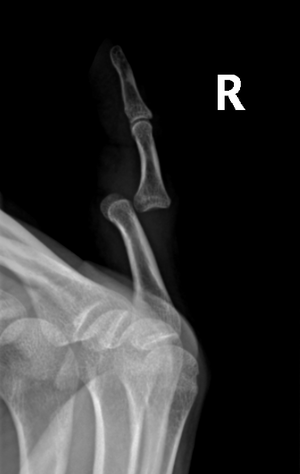We need you! Join our contributor community and become a WikEM editor through our open and transparent promotion process.
Proximal interphalangeal dislocation (finger)
From WikEM
(Redirected from Proximal interphalangeal (PIP) dislocation (finger))
Contents
Background
- Most common finger dislocation
- Volar plate ruptures in both dorsal and volar PIP dislocations [1]
- Lateral dislocations occur when one of collateral ligaments ruptures with at least partial avulsion of volar plate from middle phalanx
Clinical Features
- Mechanism: Due to axial load and hyperextension
- Finger pain/deformity
- Evaluate for extension into joint as open dislocations are common
Differential Diagnosis
Hand and finger dislocations
- Finger dislocations
- Distal interphalangeal dislocation (finger) (DIP)
- Proximal interphalangeal dislocation (finger) (PIP)
- Metacarpophalangeal dislocation (finger) (MCP)
- Thumb dislocations
- Hand dislocations
Hand and finger injuries
- Radiograph positive
- Radiograph negative
- Dupeytren contracture
- Boutonniere deformity
- Hand and finger tendon injuries
- Ganglion cyst
- De Quervain tenosynovitis
- Intersection syndrome
- Drummer's wrist
- Extensor digitorum tenosynovitis
- Vaughn Jackson syndrome
- Snapping Extensor Carpi Ulnaris
- Compressive neuropathy, "bracelet syndrome"
- Scaphoid fracture
- Osteoarthritis
- Infiltrative tenosynovitis
- Gout
- Rheumatoid arthritis
- Trigger finger
- Mallet finger
- Jersey finger
- Jammed finger
- Subungual hematoma
- Fingertip laceration
- Metacarpophalangeal (MCP) ulnar ligament rupture (Gamekeeper's thumb)
- Nail avulsion
- High-pressure injection injury
Evaluation
- X-ray finger (PA and lateral)
- True lateral of only the finger instead of hand will help detect subtle avulsion fractures [2]
Management
Reduction
- Dorsal
- Flex wrist
- Hyperextend the joint
- Apply longitudinal traction followed by dorsal pressure to phalanx base
- Irreducible cases due to entrapment of avulsion fracture, profundus tendor or volar plate
- Without initial hyperextension, can be difficult to disengage from any trapped soft tissue
- Post reduction, look for central slip rupture, which may lead to Boutonniere deformity
- Volar
- Often need open reduction due to volar plate entrapment
- Flex wrist then hyperflex the affected joint
- Apply gentle traction then extend the joint
Splinting
- Stable dorsal reduction: 3wk of immobilization in 20-30 deg of flexion
- If volar dislocation, may have injury to central slip of the extensor tendons, so must be splinted in full extension for 3 weeks to prevent Boutonniere deformity
- Unstable reduction: Surgery
- Displacement occurs during active range of motion or passive stressing of joint
- >20 deg of deformity and instability with lateral testing
Disposition
- Outpatient
- If reduced, with follow up within two weeks with hand specialist
See Also
External Links
References
- ↑ Davenport M. Procedures for orthopedic emergencies. In: Bond M, ed. Orthopedic Emergencies: Expert Management for the Emergency Physician. Cambridge: Cambridge University Press; October 31, 2013.
- ↑ Horn A. Management of Common Dislocations. In: Roberts and Hedges' Clinical Procedures in Emergency Medicine. 6th ed. Philadelphia, PA: Elsevier; 2014.


